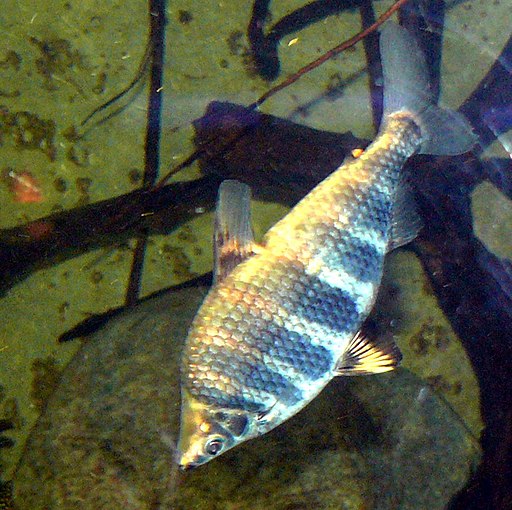Superregnum: Eukaryota
Cladus: Unikonta
Cladus: Opisthokonta
Cladus: Holozoa
Regnum: Animalia
Subregnum: Eumetazoa
Cladus: Bilateria
Cladus: Nephrozoa
Superphylum: Deuterostomia
Phylum: Chordata
Subphylum: Vertebrata
Infraphylum: Gnathostomata
Megaclassis: Osteichthyes
Superclassis/Classis: Actinopterygii
Classis/Subclassis: Actinopteri
Subclassis/Infraclassis: Neopterygii
Infraclassis: Teleostei
Megacohors: Osteoglossocephalai
Supercohors: Clupeocephala
Cohors: Otomorpha
Subcohors: Ostariophysi
Sectio: Otophysa
Ordo: Characiformes
Superfamilia: Anostomoidea
Familia: Anostomidae
Genus: Abramites
Species: Abramites hypselonotus
Name
Abramites hypselonotus (Günther, 1868)
References
Abramites hypselonotus – Taxon details on Integrated Taxonomic Information System (ITIS).
Vernacular names
Deutsch: Brachsensalmler
English: Headstander, Highbacked headstander
português: Abramites
Abramites hypselonotus – known as the marbled headstander or the high-backed headstander – is a member of the family Anostomidae[1] of the order Characiformes.[2] Under normal fish classifying rules, the marbled headstander would be classified as a surface dweller. In reality marbled headstanders – like all headstanders – inhabit the middle and lower portions of the aquarium.[3] In the wild, head standers are often found face down, tail up in narrow vertical rocky fissures.[4]
Characteristics
Marble headstanders are generally identified by their high-backed headstander,[5] pointed snout, diamond-shaped body, brown markings on pelvic fin, wavy dark brown bands, and a dark line at the base of the caudal peduncle. The marble headstanders full adult size is roughly 5" (13 cm),[3] on both sides. They are among the rarely introduced representatives of the Anostomidae and the males are more contrasted than the females.[6]
Distribution and habitat
The marbled headstander generally inhabits streams and rivers of the Orinoco and Amazon river systems.[3] Headstanders most commonly inhabit very fast flowing waters in rocky stretches of river.[4]
Diet and feeding behaviour
The marble headstander is a predominantly herbivorous fish and as such should be given a high vegetation diet. In addition to processed food, it will readily accept (and probably enjoy) lettuce leaves, and peas. They will also accept mosquito larvae and bloodworms.[4]
Aquarium care
In the aquarium, the marble headstander is known as a peaceful inhabitant. They are completely docile as juveniles both towards other fish and members of their own species. As they get older, they should be kept either as a single headstander or a group of seven or more in a tank as they tend to fight amongst themselves in smaller groups. They are still generally peaceful towards other fish.
Due to the high demand of plant food, robust plants have a small chance of survival due to the sprouting of shoots. A socialization should be done with other great tetras that have similar claims. Keep marble headstanders in a rocky, heavily planted aquarium for them to explore,[4] too small aquariums lead to increased quarrels between conspecifics, which can be avoided by sufficiently offered hiding places with roots and stone structures, consisting of cracks and crevices.[7] If there is not enough vegetation in its diet, it will devour aquarium plants. On the other hand, you can use this to your advantage if you want to set up a "self-sustaining aquarium", please keep in mind that this is not an easy task, do not just throw a bunch of plants in and think it will be fine.[4]
Temperature, pH, and salinity
These fish can tolerate a pH from 6–7.5, but prefer slightly acidic water. They like soft water ranging from 2-15 dH, and require a temperature of 73-82 °F (23-28 °C).[7]
References
Notes
Citations
"Abramites hypselonotus – Marbled Headstander (Abramites ternetzi, Abramites microcephalus) — Seriously Fish". Retrieved 2021-09-06.
"Abramites hypselonotus, Marbled headstander : fisheries, aquarium". www.fishbase.de. Retrieved 2021-09-06.
Mills, Dick (1993). Aquarium fish. Photos by Jerry Young (1st American ed.). New York: Dorling Kindersley. p. 84. ISBN 1564582930. OCLC 27679009.
Bailey, Mary (2 January 2015). The ultimate encyclopedia of aquarium fish & fish care: a definitive guide to identifying and keeping freshwater and marine fishes. Wigston, Leicestershire. p. 187. ISBN 9781780193410. OCLC 890938393.
Dawes, John; Beer, Amy Jane; Alderton, David (2005). Animal Fact Files: Fish (1st ed.). London: Greenwich Editions. ISBN 0862887747. OCLC 71766903.
Meyer, Rolf (1989). Aquarienfische (1st ed.). Leipzig: Bibliographisches Institut. p. 9. ISBN 3323002792. OCLC 22763526.
Riehl, Rüdiger (1996). Aquarium Atlas, Band 3 (in German). Vol. 3rd (1st ed.). Melle, Germany: Steven Simpson Books. p. 100. ISBN 3882440538. OCLC 35656300.
Retrieved from "http://en.wikipedia.org/"
All text is available under the terms of the GNU Free Documentation License


